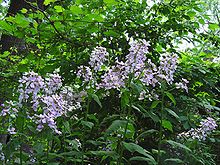- Hesperis matronalis
-
Dame's Rocket 
Scientific classification Kingdom: Plantae (unranked): Angiosperms (unranked): Eudicots (unranked): Rosids Order: Brassicales Family: Brassicaceae Genus: Hesperis Species: H. matronalis Binomial name Hesperis matronalis
L.Hesperis matronalis is a herbaceous plant species in the mustard family, Brassicaceae. It has numerous common names including: Dame’s Rocket, Damask Violet, Dame’s Violet, Dames-wort, Dame’s Gilliflower, Night Scented Gilliflower, Queen’s Gilliflower, Rogue’s Gilliflower, Summer Lilac, Sweet Rocket, Mother-of-the-evening and, Winter Gilliflower. Plants are biennials or short lived perennials, native to Eurasia and cultivated in many other areas of the world for their attractive spring blooming flowers. In some of those areas, it has escaped cultivation and become a weed species. The genus name Hesperis is Greek for evening, and the name was probably given because the scent of the flowers becomes more conspicuous towards evening.[1]
Contents
Description
Hesperis matronalis grows 100 cm or taller, with multiple upright hairy stems. Typically the first year of growth produces a mound of foliage and flowering occurs the second year, plants are normally biennials but a number of races can be short lived perennials. The plants have showy blooms in early to mid spring. The leaves are alternately arranged on upright stems and lanceolate shaped, they typically have very short or lack petioles and have toothed margins but sometimes are entire, they are widest at the base. The foliage has short hairs on the top and bottom surfaces that give the leaves a somewhat rough feel. The larger leaves are around 12 cm long and over 4 cm wide. In early spring, a thick mound of low growing foliage is produced, during flowering the lower parts of the stems are generally unbranched and denuded of foliage and the top of the blooming plant might have a few branches that end in inflorescences.
The plentiful fragrant flowers are produced in large showy terminal racemes, that can be 30+ cm tall, that elongate as the flowers of the inflorescence bloom. When stems have both flowers and fruits, the weight sometimes causes the stems to bend. Each flower is large (2 cm across), with four petals. Flower coloration varies, with different shades of lavender and purple most common, but white, pink, and even some flowers with mixed colors exist in cultivated forms. A few different double-flowered varieties also exist.[2] The four Petals are clawed and hairless. The flowers have six stamens in two groups, the 4 closest to the ovary are longer than the two oppositely positioned. Stigmas are two-lobed. The four sepals are erect and form a mock tube around the claws of the petals and are also colored similarly to the petals.[3]
Some plants may bloom until August, but warm weather greatly shortens the duration on each flowers blooming. Seeds are produced in thin fruits that are 5–14 cm long pods, containing two rows of seeds separated by a dimple. The fruits are terete and open by way of glabrous valves, constricted between the seeds like a pea-pod. Seeds are oblong shaped and 3–4 mm long and 1–1.5 mm wide. [4]
In North America, Hesperis matronalis is often confused with native Phlox species that also have similar large showy flower clusters. They can be distinguished from each other by foliage and flower differences; Dame's rocket has alternately arranged leaves and four petals per flower, while phlox have opposite leaves and five petals.
Cultivation
Hesperis matronalis has been a cultivated species for a long time and grows best in full sun to partial shade where soils are moist but have good drainage.[5] It is undemanding and self seeds quickly forming dense stands. Extensive monotypic stands of Dame's Rocket are visible from great distances; these dense collections of plants have the potential to crowd out native species when growing outside of cultivated areas.
The successful spread of Dame's Rocket in North America is attributed to its prolific seed production and because the seeds are often included in prepackaged "wildflower seed" mixes that are sold for "naturalizing". The plants typically produce a low-lying rosette of foliage the first year; in subsequent years, blooming and seed production occurs in tandem throughout the blooming season. This species is commonly found in roadside ditches, dumps and in open woodland settings, where it is noticed when in bloom. It makes an attractive, hardy garden plant and probably does not pose a threat in urban settings.
Hesperis matronalis is propagated by seeds, but desirable individuals including the double flowering forms are propagated from cuttings or division of the clumps.
Weediness
It is considered an invasive species in some areas; three U.S. states[6] have set the following legal status for it:
- Colorado: noxious weed (on B-list), with plans for eradication or management varying by area and year
- Connecticut: invasive and banned, e.g. illegal to move, sell, purchase, transplant, cultivate, or distribute
- Massachusetts: prohibited
Dame's Rocket was brought to North America in the 17th century and has since become naturalized there.
In Europe, Dame's Rocket is host to the caterpillars of several butterfly species, including the Orange tip (Anthocharis cardamines) and Small White (Pieris rapae); and moths such as Plutella porrectella.
References
- ^ Britton, N. F.; Brown, Addison (1970). An illustrated flora of the northern United States and Canada: from Newfoundland to the parallel of the southern boundary of Virginia, and from the Atlantic Ocean westward to the 102d meridian. New York: Dover Publications. pp. 175. ISBN 0-486-22643-3.
- ^ Explore Cornell - Home Gardening - Flower Growing Guides - Growing Guide
- ^ Hesperis matronalis page
- ^ Hesperis matronalis in Flora of China @ efloras.org
- ^ Hesperis matronalis
- ^ PLANTS Profile for Hesperis matronalis (dames rocket) | USDA PLANTS
External links
 Media related to Hesperis matronalis at Wikimedia Commons
Media related to Hesperis matronalis at Wikimedia Commons Chisholm, Hugh, ed (1911). "Dame's Violet". Encyclopædia Britannica (11th ed.). Cambridge University Press.
Chisholm, Hugh, ed (1911). "Dame's Violet". Encyclopædia Britannica (11th ed.). Cambridge University Press.
Categories:- Night-blooming plants
- Brassicaceae
- Garden plants
Wikimedia Foundation. 2010.



